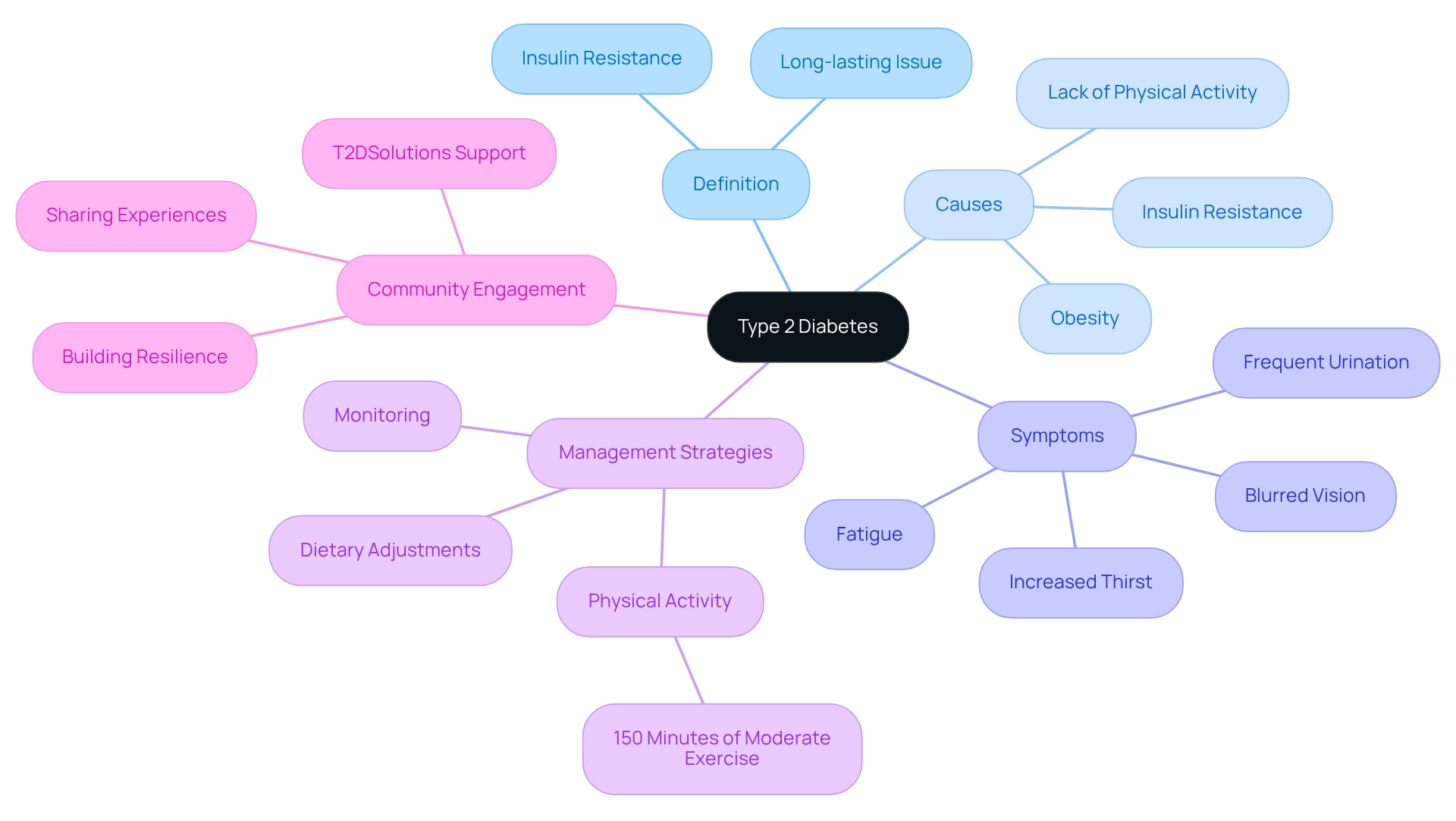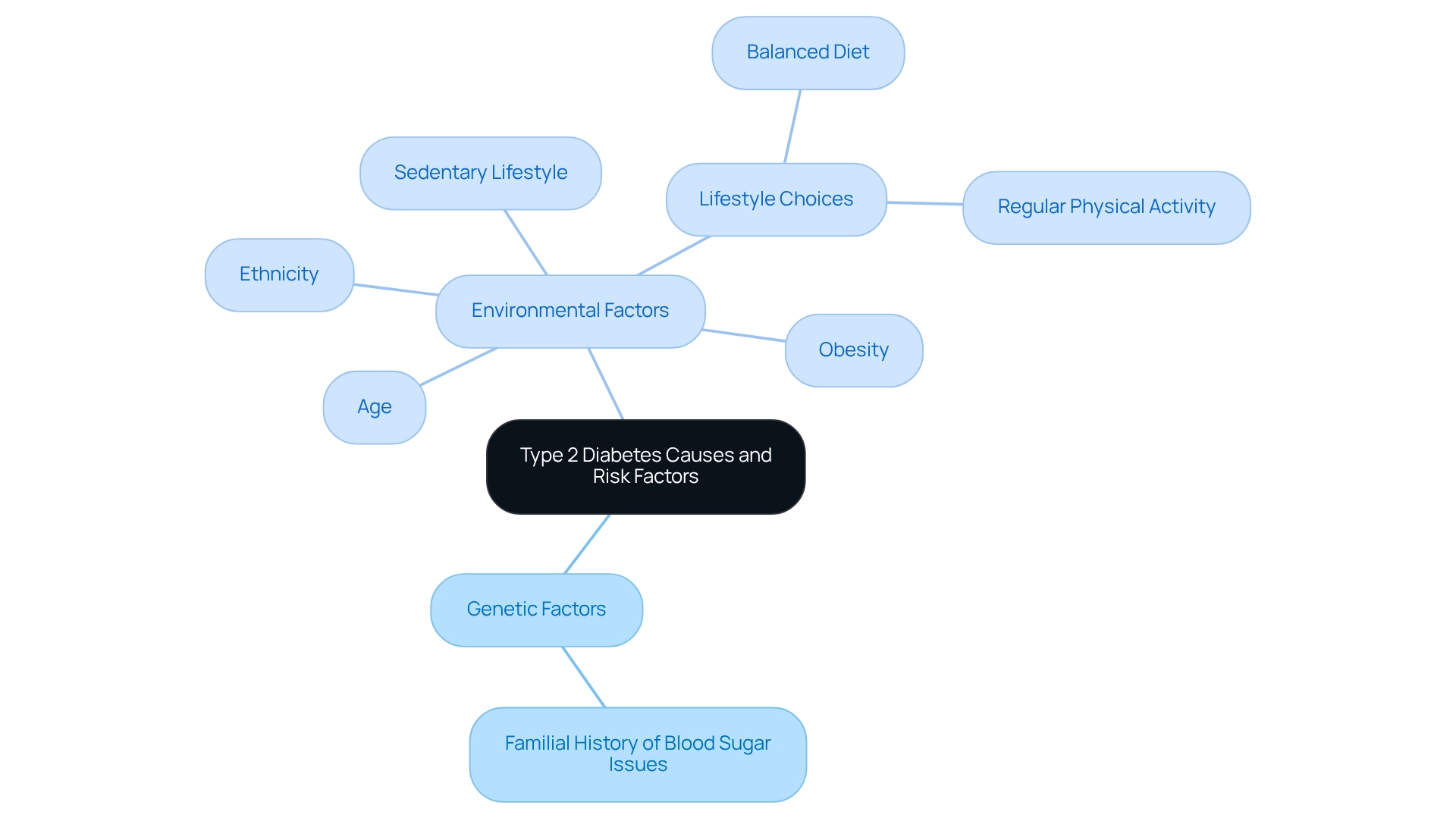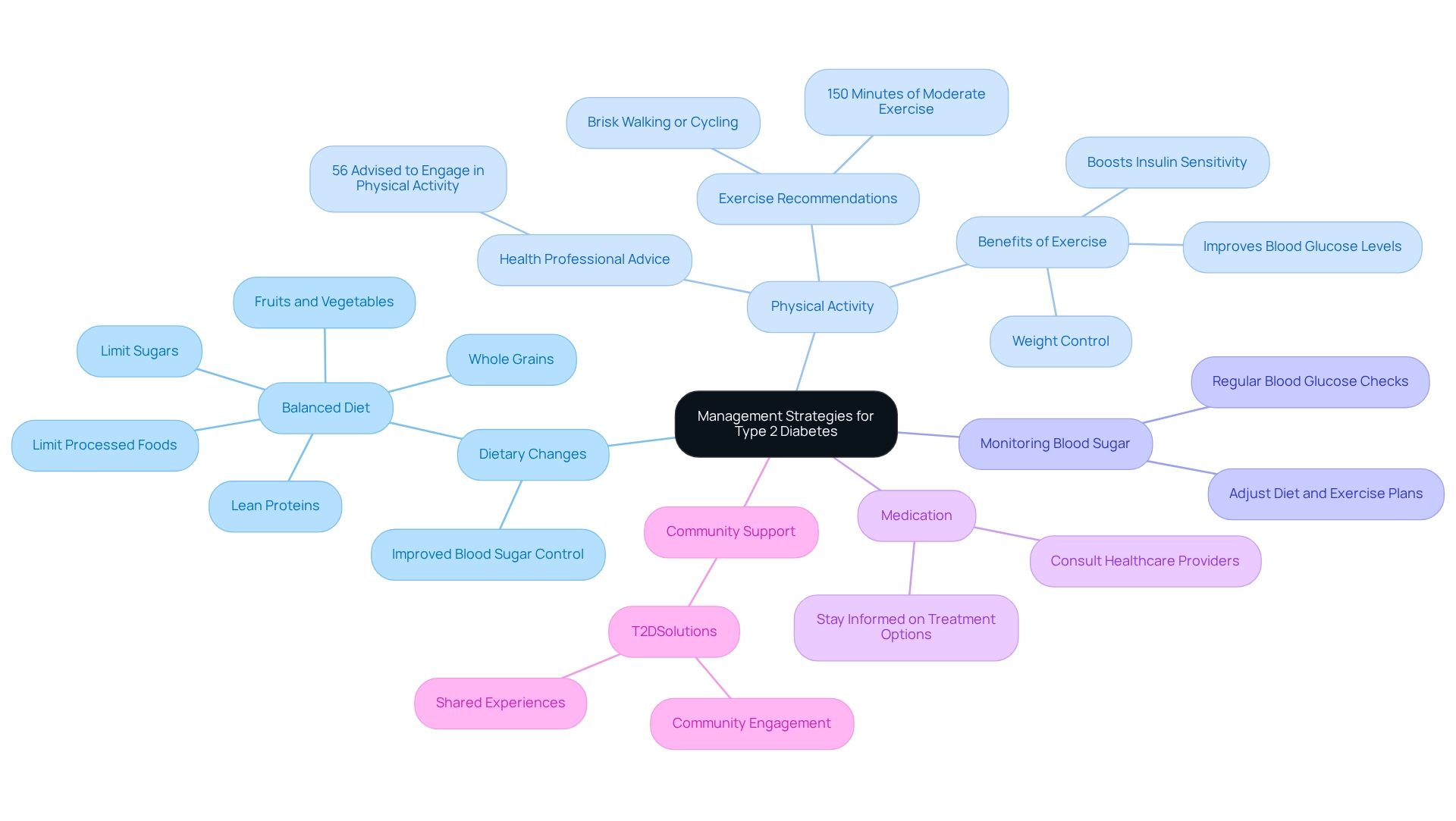Overview
Type 2 diabetes is a chronic condition that many people face, characterized by insulin resistance. This can lead to elevated blood sugar levels, and it's important to recognize how significantly lifestyle factors—such as obesity and physical inactivity—play a role. It's understandable to feel overwhelmed by this diagnosis, but effective management is within reach.
Making lifestyle changes is crucial. Adopting a balanced diet and incorporating regular exercise can make a world of difference. Additionally, seeking community support and education can greatly improve health outcomes and blood sugar control. Remember, you’re not alone in this journey—there are resources and people ready to help you every step of the way.
Consider connecting with others who share similar experiences. Sharing your story can foster a sense of belonging and support. Together, we can navigate the challenges of Type 2 diabetes and work towards a healthier future.
Introduction
Type 2 Diabetes has emerged as a significant health concern, affecting approximately 1 in 10 Americans. This highlights an urgent need for awareness and education. It's understandable to feel overwhelmed by this chronic condition, characterized by insulin resistance and often linked to lifestyle choices such as obesity and inactivity. Unlike Type 1 Diabetes, which usually appears in childhood, Type 2 can often be managed through proactive lifestyle changes and medical interventions.
As research reveals the profound impact of early diagnosis and community support on effective management, understanding the symptoms, causes, and strategies for living well with Type 2 Diabetes becomes essential. You're not alone in this journey; many individuals are navigating similar paths. This article delves into the critical aspects of Type 2 Diabetes, offering insights into its management and the importance of connecting with others for support on the journey to better health.
Define Type 2 Diabetes: Key Concepts and Overview
Condition 2 is a long-lasting issue characterized by insulin resistance, where the body struggles to use insulin efficiently, leading to higher blood sugar levels. This condition often appears in adults and is closely linked to lifestyle factors such as obesity and a lack of physical activity. Unlike the first type, which is frequently identified during childhood and involves little to no insulin production, the second type can often be managed through lifestyle changes and medical treatments.
Currently, about 1 in 10 Americans are living with this condition, highlighting the importance of awareness and education. Recent research underscores that insulin resistance is a critical factor in the development of this issue. Studies show that lifestyle changes, including regular physical activity—aiming for at least 150 minutes of moderate exercise each week—can significantly lower the risk of developing this condition.
As we navigate the landscape of diabetes management, it’s essential to recognize the value of early diagnosis and proactive education. Effective management strategies involve dietary adjustments, increased physical activity, and regular monitoring of blood sugar levels. Understanding diabetes type 2 is crucial for effective management, as many individuals who embrace healthier lifestyles often experience better blood sugar regulation and overall well-being. Symptoms may include increased thirst, frequent urination, fatigue, and blurred vision. Recognizing these signs early can lead to timely intervention, which is vital for preventing complications.
Moreover, community engagement plays a significant role in managing Type 2 Diabetes. T2DSolutions creates a supportive environment where individuals can share their experiences and connect with others facing similar challenges. This fosters resilience and hope. You're not alone in this journey; the shared pursuit of improved health is enriched by a wealth of resources and expert knowledge available, empowering you to make informed choices about managing your condition.

Identify Symptoms: Recognizing the Signs of Type 2 Diabetes
Understanding diabetes type 2 can help identify common symptoms, which may include:
- Increased thirst
- Frequent urination
- Extreme fatigue
- Blurred vision
- Slow healing of cuts or bruises
These symptoms often develop gradually, making them easy to overlook. It's understandable that many individuals first associate their fatigue with stress or aging, only to later discover it’s linked to a health condition involving blood sugar. Recognizing these signs early is vital for understanding diabetes type 2, as timely medical intervention can significantly improve management outcomes.
Remember, approximately 1 in 10 Americans has diabetes, which highlights the prevalence of this condition and the importance of understanding diabetes type 2; healthcare professionals emphasize the need for vigilance regarding these symptoms. Early diagnosis rates are crucial, as they can lead to better management strategies and an improved quality of life.
Studies indicate that individuals who identify symptoms early are more likely to receive appropriate care and support. If you experience any of these symptoms, consulting a healthcare professional for further evaluation and potential testing is advisable. You're not alone in this journey; having a support system of individuals who understand the challenges of living with this condition can make a significant difference in your experience.

Explore Causes and Risk Factors: Understanding What Leads to Type 2 Diabetes
Understanding diabetes type 2 is crucial because this condition arises from a complex interplay of genetic and environmental factors, and it’s important to comprehend how these elements affect you. Key risk factors include:
- Obesity
- A sedentary lifestyle
- A familial history of blood sugar issues
Age and ethnicity also play significant roles, with certain populations being more susceptible. Currently, over 100 million Americans live with prediabetes and related conditions, highlighting the urgent need to address these risk factors. Health issues like hypertension and elevated cholesterol can increase your risk, making it essential to comprehend your personal health profile.
Recent studies emphasize how lifestyle decisions impact diabetes risk. Engaging in regular physical activity and maintaining a balanced diet are essential for understanding diabetes type 2 and significantly reducing the likelihood of developing it. Many individuals have successfully lowered their risk through lifestyle modifications, reinforcing the idea that understanding diabetes type 2 is essential for proactive health management. You're not alone in this journey; there are countless stories of triumph that can inspire you.
Expert insights into understanding diabetes type 2 reveal that genetics can predispose individuals to insulin resistance, but environmental factors, such as diet and exercise, are pivotal in determining whether these genetic risks manifest. As Dr. Dinesh Kacha observes, tackling the root causes of insulin resistance through lifestyle changes can not only avert the condition but also reverse its impacts. This comprehensive approach highlights that managing this condition is a joint endeavor. Together, with mutual understanding and support, we can work towards better health outcomes for everyone involved. Remember, we are here to support you every step of the way.

Implement Management Strategies: Lifestyle Changes and Treatment Options
Managing Type 2 Diabetes can feel overwhelming, but understanding diabetes type 2 helps remind you that you're not alone in this journey. A multifaceted approach, including dietary changes, regular physical activity, and medication when necessary, is essential for understanding diabetes type 2. Here are some key strategies to consider:
- Dietary Changes: Focus on a balanced diet rich in whole grains, lean proteins, fruits, and vegetables while limiting processed foods and sugars. Recent studies indicate that dietary changes can significantly improve blood sugar control. Many patients have reported better outcomes after adopting healthier eating habits, and understanding diabetes type 2 can help you enjoy these benefits too.
- Physical Activity: Aim for at least 150 minutes of moderate exercise per week, such as brisk walking or cycling. In fact, 56% of individuals with the condition who consulted a health professional were advised to engage in physical activity. This highlights its significance in managing your health. Consistent physical exercise not only helps with weight control but also boosts insulin sensitivity, leading to better blood sugar regulation. Real-world examples show that those who incorporate exercise into their routines experience notable improvements in their blood glucose levels.
- Monitoring Blood Sugar: Regularly checking your blood glucose levels is essential for understanding diabetes type 2 and how food and activity influence your condition. This practice allows for timely adjustments to your diet and exercise plans, fostering better control over your blood sugar levels.
- Medication: It's important to consult with healthcare providers about medications that may be necessary to help manage your blood sugar levels effectively. Staying informed about recent advancements in treatment options can empower you to make educated decisions regarding understanding diabetes type 2.
As Peter M. House aptly stated, "Diabetes is not a burden, but a lesson in perseverance and self-care." Implementing these strategies can lead to improved blood sugar control and a better quality of life. By cultivating a supportive community through T2DSolutions and exchanging experiences, you can discover encouragement and motivation in your health management journey. T2DSolutions highlights the significance of community support and shared experiences in managing this condition effectively. By partnering with community initiatives, you can improve your blood sugar management and overall health. Remember, we are here to support you every step of the way.

Engage with Community Support: Resources and Shared Experiences
Engaging with community support can significantly enhance the understanding of diabetes type 2 and its management. Resources like local support groups, online forums, and education programs create valuable opportunities for individuals to share experiences, learn from each other, and receive encouragement. Organizations such as the American Diabetes Association and local health departments often provide workshops, seminars, and customized resources for those managing the condition. Participating in these support networks has been shown to improve health outcomes; for instance, studies indicate that individuals involved in peer support programs experience notable reductions in fasting blood glucose levels compared to those receiving usual care.
The benefits of community support extend beyond clinical metrics. Many individuals report feeling less isolated and more empowered to take charge of their health when they connect with others facing similar challenges. Expert insights suggest that shared experiences within these groups cultivate resilience and offer practical strategies for effectively managing the condition. Recent initiatives in blood sugar education emphasize the significance of incorporating peer support elements into self-management education (SME), encouraging healthcare providers to create compact intervention programs that enhance self-management practices.
Statistics indicate that involving households and healthcare providers in these support programs can lead to improved outcomes, with some studies demonstrating a mean decrease in HbA1c levels by 0.35% after six months of participation. Real-life examples from diabetes support groups illustrate how understanding diabetes type 2 and collective knowledge can transform individual experiences, making the journey of managing Type 2 Diabetes a shared and supportive endeavor. You're not alone in this journey; we are here to support you every step of the way.

Conclusion
Understanding Type 2 Diabetes is crucial for effective management and improved quality of life. This chronic condition, characterized by insulin resistance, is influenced by lifestyle choices such as diet and physical activity. It's understandable to feel overwhelmed by the symptoms, including increased thirst and fatigue, but recognizing them early can lead to timely intervention and better management outcomes. With approximately 1 in 10 Americans affected, raising awareness around the causes, risk factors, and the importance of lifestyle changes is essential in combating this significant health concern.
Implementing effective management strategies is key to living well with Type 2 Diabetes. Adopting a balanced diet, engaging in regular physical activity, monitoring blood sugar levels, and consulting healthcare professionals for medication when necessary can empower you to take control of your health. Moreover, fostering community support through local groups and online forums enhances your management journey, providing encouragement and shared experiences that can lead to improved health outcomes.
Ultimately, navigating the complexities of Type 2 Diabetes requires a proactive and informed approach. By embracing lifestyle modifications and seeking support from others facing similar challenges, you can transform your health journey into a path of resilience and empowerment. Remember, you're not alone in this journey; with the right resources and community backing, a healthier future is attainable.
Frequently Asked Questions
What is Condition 2, and how does it relate to insulin resistance?
Condition 2, also known as Type 2 Diabetes, is a long-lasting issue characterized by insulin resistance, where the body struggles to use insulin efficiently, leading to higher blood sugar levels. It is often linked to lifestyle factors such as obesity and a lack of physical activity.
How does Type 2 Diabetes differ from Type 1 Diabetes?
Unlike Type 1 Diabetes, which is frequently identified during childhood and involves little to no insulin production, Type 2 Diabetes can often be managed through lifestyle changes and medical treatments.
What is the prevalence of Type 2 Diabetes in the United States?
Currently, about 1 in 10 Americans are living with Type 2 Diabetes, highlighting the importance of awareness and education regarding the condition.
What lifestyle changes can help lower the risk of developing Type 2 Diabetes?
Regular physical activity, aiming for at least 150 minutes of moderate exercise each week, along with dietary adjustments, can significantly lower the risk of developing Type 2 Diabetes.
What are common symptoms of Type 2 Diabetes?
Common symptoms include increased thirst, frequent urination, extreme fatigue, blurred vision, and slow healing of cuts or bruises.
Why is early recognition of symptoms important in managing Type 2 Diabetes?
Recognizing symptoms early is vital for understanding Type 2 Diabetes, as timely medical intervention can significantly improve management outcomes and prevent complications.
What role does community engagement play in managing Type 2 Diabetes?
Community engagement, such as that provided by T2DSolutions, creates a supportive environment where individuals can share experiences and connect with others, fostering resilience and hope in managing their condition.
What should individuals do if they experience symptoms of Type 2 Diabetes?
If individuals experience symptoms of Type 2 Diabetes, it is advisable to consult a healthcare professional for further evaluation and potential testing.



